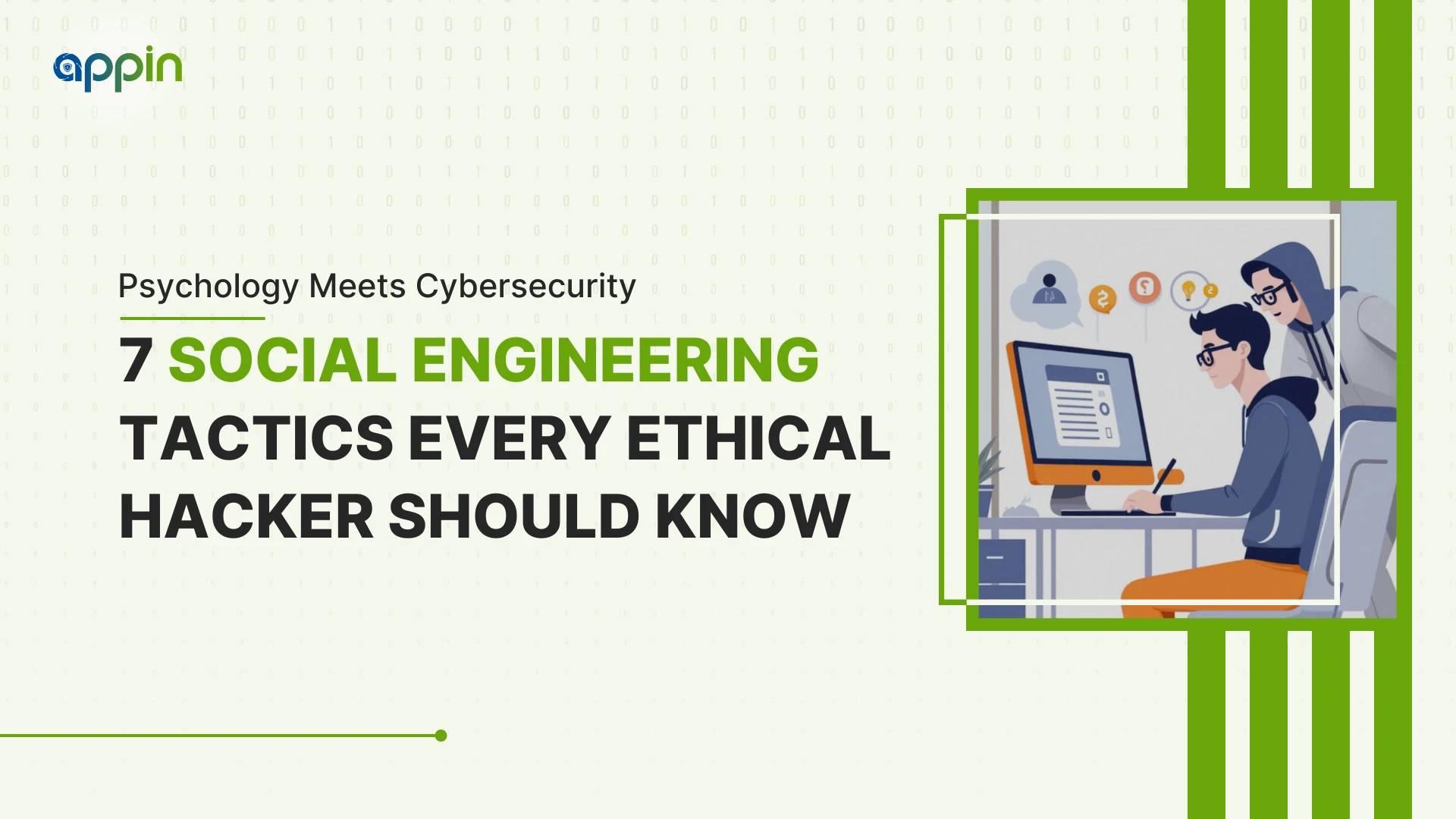Social engineering remains one of the most effective and dangerous forms of cyberattack. While firewalls and endpoint protection get smarter, humans are still the easiest target in most systems.
And in 2024 and beyond, attackers are getting bolder, faster, and more creative. From fake job offers to deepfake videos, the methods have changed, but the goal remains the same: to manipulate trust to bypass security.
If you’re serious about understanding modern threats, these are the seven social engineering tactics you need to watch and simulate in your ethical hacking strategy.
Spear Phishing with Contextual Intelligence
Phishing isn’t just about suspicious links or generic emails anymore. Spear phishing has become dangerously precise, powered by contextual data and AI-generated content that mirrors the tone, timing, and details of legitimate communication.
Attackers now build profiles on individuals using:
- Social media activity (LinkedIn roles, tweets, GitHub commits)
- Leaked credentials and data dumps from previous breaches
- Public bios, conference speaker lists, or press mentions
- Behavioral patterns like when someone’s typically online or who they interact with
Using this data, they craft messages that reference recent meetings, project names, or internal team members. These messages don’t raise red flags because they feel like they belong in your inbox.
What makes them even more effective is the use of AI:
- Language models generate emails that mimic internal writing styles, from punctuation to tone
- Grammar and formatting are near-perfect, unlike traditional phishing
- Subject lines are tested and refined using data-driven techniques for maximum click rates
The result is a phishing attempt that reads like it came from your boss, your HR department, or even your team. One click could mean full access.
For ethical hackers, replicating this level of precision is essential. During red team simulations, it allows you to:
- Show how easy it is to exploit human trust with minimal tech intrusion
- Reveal which teams are most vulnerable to social context attacks
- Help organizations build smarter, context-aware training, not just generic phishing awareness
Spear phishing isn’t just a technical challenge, it’s a psychological one. And defending against it means thinking two steps ahead of the attacker.
Pretexting: Fake Roles, Real Threats
Pretexting is one of the oldest and most dangerous social engineering tactics, and it’s evolving fast. Instead of relying on malware or exploits, this tactic manipulates trust through believable narratives. The attacker assumes a role of authority, urgency, or familiarity to trick someone into giving away sensitive information or system access.
What makes pretexting so effective is its reliance on psychological triggers:
- Authority — The attacker poses as a senior executive, IT admin, or external auditor
- Urgency — The scenario often involves a time-sensitive issue, like a security breach or compliance failure
- Legitimacy — Fake credentials, email signatures, or cloned websites add credibility to the act
Here are some pretexting tactics you should be watching:
- Spoofed IT support calls requesting credentials or remote access to “fix a breach”
- Vendor impersonation asking to update payment details or verify contract data
- Recruitment scams lure targets into fake interviews or job application processes
- Security audits that pressure targets into sharing logins or downloading tracking tools
Attackers often back up their stories with publicly available information:
- Internal lingo pulled from LinkedIn job descriptions
- Names of actual employees found through social media
- Email formatting cloned from company newsletters
In remote or hybrid workplaces, the risk increases:
- People don’t always know who works in which department
- Calls and emails from outside the office feel more normal
- The absence of face-to-face verification makes deception easier
For ethical hackers, simulating pretexting is a crucial test of organizational resilience. It helps:
- Expose gaps in identity verification processes
- Reveal how staff respond to authority or urgency
- Evaluate escalation protocols when unusual requests are made
Pretexting doesn’t break in through the firewall, it walks through the front door. And that’s exactly why it must be part of every ethical hacker’s toolkit.
Deepfake Voice and Video Calls
Deepfake technology has shifted from novelty to a genuine cybersecurity threat. What was once an experimental AI project is now a practical weapon in social engineering, one that mimics not just words, but trust, tone, and identity.
With just a few seconds of publicly available audio, often scraped from interviews, social media, or recorded calls, AI can clone a voice that’s indistinguishable from the real person. Add synthetic video generation, and the attacker now has a full impersonation toolkit.
These deepfakes are being used in real attacks, including:
- Impersonating executives during Zoom calls to approve wire transfers or request sensitive data
- Sending pre-recorded voice notes to junior staff, making urgent demands
- Creating short video clips of known team leads giving false instructions or account access permissions
Why it works:
- Deepfakes bypass traditional red flags like bad grammar or strange email addresses
- They rely on trust and familiarity, people are more likely to act without verification when they recognize a voice or face
- These attacks are fast, leaving little time for hesitation or escalation
The risk is particularly high in:
- Remote-first teams, where people don’t meet in person and rely heavily on video communication
- Large organizations, where not everyone knows who reports to whom
- Time-sensitive environments, like finance, HR, and operations, where delay feels riskier than action
For ethical hackers, testing deepfake scenarios isn’t about scaring people, it’s about preparing them. You can simulate these situations to assess:
- Whether staff are trained to verify voice/video instructions through a second channel
- If departments have internal protocols for validating requests that come from “above,”
- How fast teams can detect inconsistencies in speech, tone, or behavior
Deepfakes are no longer theoretical. They’re real, accessible, and actively used in corporate fraud. Preparing for them means not just updating systems, but changing habits. Because when the threat sounds like someone you trust, instinct kicks in before policy.
Quizzes, Surveys, and Fake Forms
Not every cyber threat looks like a breach. Some arrive disguised as engagement quizzes, polls, surveys, or feedback forms that seem routine, internal, or even entertaining. These tactics prey on curiosity, trust, and routine behavior to harvest sensitive data without raising alarms.
Today’s attackers use well-crafted forms to extract:
- Login credentials under the guise of “account re-verification”
- Personal info such as name, date of birth, or ID numbers via fake HR surveys
- Security question answers through friendly-sounding personality quizzes or contests
- Sensitive company insights like team structures, tools, or project names
What makes these forms effective?
- Professional design—they mimic corporate styling, logos, and internal lingo
- Trusted domains—often hosted on well-known survey platforms like Google Forms or Typeform
- Urgency or incentives—such as deadlines for benefits enrollment or gift card rewards for participation
- Contextual relevance—targeted to match ongoing events like remote work check-ins, hiring campaigns, or cybersecurity training
Attackers then use this harvested data to fuel larger campaigns:
- Spear phishing: using personal responses to create highly specific email attacks
- Credential stuffing: testing login details across multiple platforms
- Social profiling: understanding the tone, tools, and timing of internal communication
For ethical hackers, these tactics are critical to simulate. You can test:
- How easily employees submit information without verifying the source or purpose
- Which teams are more prone to oversharing when forms appear official
- Whether security awareness training includes recognition of this subtle attack vector
Quizzes and surveys might feel low-risk, but they often lay the groundwork for high-impact breaches. In a world where phishing looks like participation, awareness has to extend beyond inboxes and into everyday behaviors.
Shoulder Surfing and Physical Breach Attempts
Not all attacks happen behind a keyboard. Some of the most successful breaches start in person, through proximity, distraction, and misplaced trust. Social engineering in physical environments often flies under the radar because it doesn’t rely on malware or code. It relies on human behavior.
Shoulder surfing, watching someone enter a password, PIN, or view sensitive information, is just one piece of the puzzle. More advanced tactics involve entering secure areas through tailgating, impersonation, or exploiting gaps in building protocols.
Common breach methods include:
- Tailgating into buildings by following employees through security doors
- Impersonating contractors, delivery staff, or vendors using fake IDs and uniforms
- Installing rogue devices (like USB rubber duckies or keyloggers) on unattended workstations
Accessing unlocked devices, printed credentials, or confidential documents left in meeting rooms
Why it works:
- Many employees are conditioned to be helpful or non-confrontational
- Busy offices often skip ID checks or assume someone else has verified a visitor
- Physical security training is often lacking or outdated, especially in hybrid work models
For ethical hackers, physical penetration testing isn’t about breaking in; it’s about showing how vulnerable environments are. These tests can reveal:
- Whether employees challenge unknown visitors
- How easily sensitive areas can be accessed or devices connected
- Gaps in security protocols like badge checks, camera coverage, or visitor logs
Digital defenses are essential, but they’re only part of the picture. A strong cybersecurity posture must include physical security awareness, clear access protocols, and response training for real-world breach attempts.
Because all it takes is one unlocked screen or one overlooked USB port for a major compromise to begin, and no firewall can stop someone who’s already inside.
Quishing: QR Code-Based Phishing
Quishing—Phishing through QR codes is one of the fastest-growing attack vectors in social engineering. As QR codes have become a normalized part of daily life, attackers are quietly embedding malicious payloads in what most people now scan without a second thought.
These attacks exploit both user habits and technical blind spots:
- Most people no longer scrutinize QR codes the way they do email links
- There’s no visible URL before scanning, which removes a key layer of user control
- Scanning feels safe because it’s used in everything from menus to payments
Common attack formats include:
- Fake surveys or feedback forms placed in office breakrooms or emailed in internal announcements
- Event check-ins at conferences or company training sessions that capture login credentials or install tracking scripts
- Public signage and posters, such as “scan for Wi-Fi” or “view parking rates,” were swapped with malicious code
- Package delivery slips with QR codes leading to fake courier websites that harvest payment info
Because QR codes are image-based, they bypass traditional email filters and antivirus tools. This makes them an attractive option for attackers looking to avoid detection while targeting mobile users, especially in BYOD (Bring Your Own Device) environments.
For ethical hackers, including quishing in red-team testing is critical:
- Test how users respond to QR codes embedded in physical or digital spaces
- Evaluate whether mobile device security is monitored in hybrid work setups
- Assess if teams have training that covers modern, image-based phishing risks
Quishing isn’t just a niche trick, it’s a subtle, scalable method of attack that blends into environments people already trust. If users are scanning without questioning, your organization is exposed.
And it’s up to ethical hackers to simulate that reality before attackers exploit it.
Business Email Compromise (BEC)
Business Email Compromise (BEC) isn’t about malware, it’s about trust. And that’s exactly what makes it one of the most damaging and difficult social engineering tactics to detect. In a BEC attack, the threat comes from what appears to be a legitimate, familiar source: a trusted colleague, an executive, or a long-time vendor.
The attacker either gains access to or convincingly spoofs a real business email account. From there, they manipulate internal workflows, relying on urgency, hierarchy, or routine to trigger a response.
Here’s how BEC attacks typically play out:
- Email account compromise through credential theft or phishing
- Domain spoofing to create near-identical addresses (e.g., johndoe@company.com → johndoe@c0mpany.com)
- Internal language mimicry mirrors how actual executives or departments write and sign off
The attacker might then:
- Request a wire transfer for a fake invoice
- Ask for W-2 forms, tax data, or employee records
- Instruct someone to change payroll or vendor payment info
Send an urgent message to bypass normal approval protocols
Why it works:
- The sender’s identity looks trustworthy at first glance
- The timing often aligns with business travel, leadership transitions, or finance deadlines
- Many employees hesitate to question or delay instructions from higher-ups
The financial and reputational damage from BEC can be massive:
- The FBI reports billions in global losses from BEC-related scams annually
- These attacks often bypass technical defenses like firewalls and antivirus software
- They can go undetected until the financial damage is irreversible
For ethical hackers, simulating BEC is essential for testing:
- Internal escalation paths—do employees know when and how to verify a financial request?
- Executive impersonation response—is there training in place to detect tone or context mismatches?
- Protocol discipline—are finance and HR teams following a second-factor validation rule before major actions?
BEC proves that even the strongest tech stack can be undone by a single moment of unverified trust. Ethical hackers help teams build the reflex to question, even when the email comes from the top.
Why Ethical Hackers Need to Think Like Social Engineers
You can’t defend what you don’t understand. These attacks don’t rely on malware or brute force; they rely on emotion, urgency, and familiarity. That means your defenses must go beyond code; they must include behavior.
- Think like a social engineer to spot where real users are most vulnerable
- Test beyond the login page target processes, habits, and assumptions
- Train teams to recognize manipulation, not just malware
Ethical hacking isn’t about outsmarting systems, it’s about understanding people. And the more you know about these tactics, the more resilient your defense strategies become.
How Appin Helps You Master Social Engineering Defense
Appin is where future cyber professionals learn to think like real-world attackers so they can defend with clarity and precision. Our hands-on programs include:
- Real-time social engineering simulations, from spear phishing to deepfakes
- Physical and digital penetration testing labs
- Behavioral analysis training for modern threat detection
- Mentorship from ethical hackers actively working in the field
At Appin, you don’t just study tactics, you practice them. So when the real attack happens, you’ve already seen it coming. Connect with ethical hacking experts and learn how things work!





